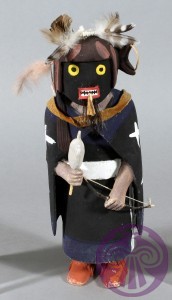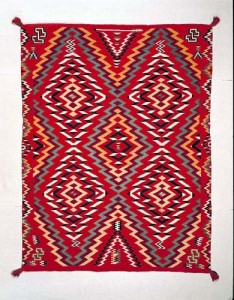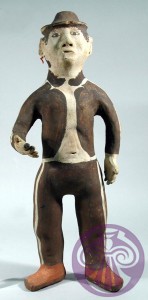
The Ethnology Collection (over 15,000 objects) contains significant Hopi and Navajo objects with smaller holdings from Zuni and the Apache Bands. The collection also contains representative holdings from other Pueblo groups (Acoma, San Ildefonso, Santa Clara, etc.), and Havasupai and Colorado Plateau Tribes. These collections include accoutrements, baskets, carved figures, ceramics, cradleboards, jewelry, musical instruments, textiles, tools, toys, weapons, and other items. The following information includes highlights of the collection:
- 850 Navajo and Hopi weaving tools, wool and dye samples including dye experiments and samples that culminated in Mrs. Colton’s Hopi Dyes book as well as Marsha Gallagher’s work with Navajo weaver, Margaret Grieves, that documented the effort required to weave a Navajo textile from start to finish.
- 200 Trading Post tokens primarily from the Gregory C. Diers bequest.
- 40 pieces of Horse and burro equipment including a Navajo saddle with 19 lbs of silver and 1000 carats of Blue Gem Turquoise by Ivan Kee and Ray de Berge
Hopi (Approximately 5100 objects)
- 1300 ceramic jars, bowls, canteens, tiles, and other objects, some as early as the 1700s but gaining strength from the mid-1800s on, with works by Nampeyo and Nampeyo family, Polingaysi Qoawyma (Elizabeth White), Garnet Pavatea, Sadie Adams, and other noted ceramists.
- 1000 katsina dolls and carved figures, of which approximately 30 that predate 1900 and one that predates 1850. Over 120 are by Jimmy Kewanwytewa (Jimmy K.).
- 700 wicker, coil, and plaited baskets, many of traditional vegetal dyes from early in the 20th century.
- 400 textiles (belts, sashes, kilts, robes, wearing blankets, rabbit skin blankets, wedding suitcases, etc.) that are annually studied by Hopi men and boys learning traditional weaving.
- 450 pieces of jewelry, many by noted Hopi silversmiths as well as a jewelry making tool kit used by Duwakuku. This collection contains some of the earliest examples of Hopi overlay and the 1938 watercolor designs that served as an influence as this style evolved (see Hopi Silver by Margaret Wright).
Navajo (Approximately 3700 objects)
- 900 weavings from late Classic to modern regional styles. Of particular note is the Hattie Gladwin collection that contains 130 Navajo textiles. A 2006 report by Dr. Laurie Webster discusses the strengths and needs of the collection. Click here to download the 2006 Webster Report. Click here to download Navajo Staples Rug (E1875) article.
- 250 ceramic jars, bowls, and effigy vessels, etc.) from the 20th century by noted ceramists Alice Cling, Louise Goodman, Betty Manygoats, and others.
- 110 Navajo and Paiute baskets dating from the 1890s to the present.
- 1450 pieces of jewelry (necklaces, bracelets, pins, buttons, belts, etc.) dating from the 1880s including jewelry making tools and molds for sand casting.
Zuni (Approximately 850 objects)
- 300 pieces of jewelry (bracelets, necklaces, pins, bolos, etc. in petit point and inlay) by Leekya Deyuse, Zuni Dick, David Tsikewa and others.
- 180 ceramic jars, bowls, canteens from 1750 to present.
- 120 fetishes that span the 20th century with several by Leekya Deyuse, Sarah Leekya Deyuse, Teddy Weahkee, and Theodore Kucate
Apache (Approximately 300 objects)
- 130 baskets from the 1870s through the 20th century.
- 17 ceramic jars primarily from the 1930s



